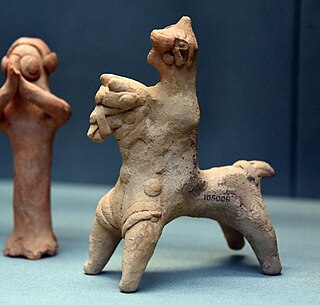 W
WThe Braak Bog Figures are two wooden carvings discovered in 1947 in a peat bog in Braak, Schleswig-Holstein, Northern Germany. Part of a larger tradition of similar figures spanning the period from the Neolithic to the Middle Ages, they are human-like in appearance and have been carbon dated to the 2nd or 3rd century BCE; the Schleswig-Holstein state archaeology museum puts them as far back as 400BCE. Several hypotheses have been proposed to explain their function and what they may represent, from depictions of deities to ancestor worship.
 W
WThe Euphrates Handmade Syrian Horses and Riders are zoomorphic clay figurines representing both solely horses or horses provided with riders and dating from the late Iron Age period. These figurines are produced in the Middle Euphrates region and they belong to a production comprehending some anthropomorphic specimens, i.e. the Euphrates Syrian Pillar Figurines (EU_SPF's).
 W
WThe Euphrates Syrian Pillar Figurines (EU_SPF's) are anthropomorphic clay figurines dating from the late Iron Age period and produced in the Middle Euphrates region. These figurines are part of a greater coroplastic production mainly composed of handmade horse-rider figurines, i.e. the Euphrates Handmade Syrian Horses and Riders (EU_HSHR's).
 W
WThe Leekfrith torcs are four Iron Age gold torcs found by two hobby metal detectorists in December 2016 in a field in Leekfrith, north Staffordshire, England. The find consists of three neck torcs and a smaller bracelet, which were located in proximity to each other. They are believed to be the oldest Iron Age gold jewellery found in Britain. Subsequent archaeological examination of the area did not uncover further objects.
 W
WLuristan bronzes are small cast objects decorated with bronze sculpture from the Early Iron Age which have been found in large numbers in Lorestān Province and Kermanshah in western Iran. They include a great number of ornaments, tools, weapons, horse-fittings and a smaller number of vessels including situlae, and those found in recorded excavations are generally found in burials. The ethnicity of the people who created them remains unclear, though they may well have been Persian, possibly related to the modern Lur people who have given their name to the area. They probably date to between about 1000 and 650 BC.
 W
WThe term toreutics, relatively rarely used in English, refers to artistic metalworking – hammering gold or silver, engraving, or using repoussé and chasing to form minute detailed reliefs or small engraved patterns. Toreutics can include metal-engraving – forward-pressure linear metal removal with a burin.
 W
WThe art of Urartu refers to a historical and regional type of art from Urartu (Ararat), the ancient state of Western Asia which existed in the period from the 13th to the 6th centuries BC in the Armenian Highland. The art of Urartu was strongly influenced by nearby Assyria, the most prominent state of that period in the region. It peaked around the 8th century BC but was mostly looted, scattered and destroyed with the fall of Urartu about a century later.